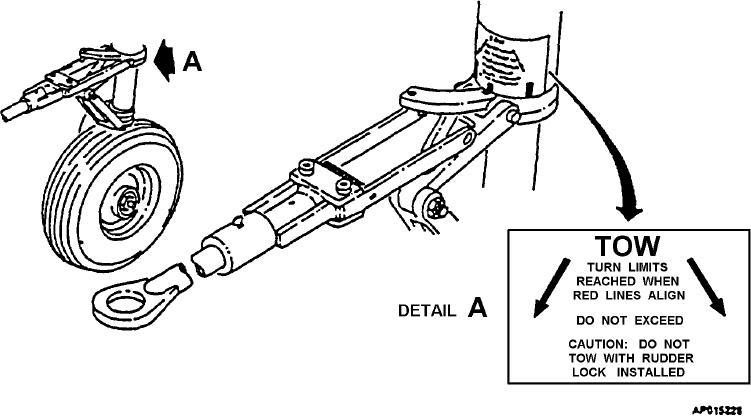
TM 1-1510-262-10
d. Ground Handling Under Extreme Weather Conditions. Extreme weather conditions necessitate particular
care in ground handling of the aircraft. In hot, dry, sandy, desert conditions, special attention must be devoted to
inding a irmly packed parking and towing area. If such areas are not available, steel mats or an equivalent solid
base must be provided for these purposes. In wet, swampy areas, care must be taken to avoid bogging down the
aircraft. Under cold, icy, arctic conditions, additional mooring is required, and added precautions must be taken to
avoid skidding during towing operations.
Figure 2-47. Towing, Turn Limits
2-105. PARKING.
Parking is deined as the normal condition under which the aircraft will be secured while on the ground. This condition
may vary from the temporary expedient of setting the parking brake and chocking the wheels to the more elaborate
mooring procedures described under Mooring. The proper steps for securing the aircraft must be based on the time
the aircraft will be left unattended, the aircraft weights, the expected wind direction and velocity, and the anticipated
availability of ground and aircrews for mooring and/or evacuation. When practical head the aircraft into the wind,
especially if strong winds are forecast or if it will be necessary to leave the aircraft overnight. Set the parking brake
and chock the wheels securely. Following engine shutdown, position and engage the control locks.
NOTE
Cowlings and loose equipment will be suitably secured at all times when left in an unattended con-
dition.
a. The parking brake system for the aircraft incorporates two lever-type valves, one for each wheel brake. Both
valves are closed simultaneously by pulling out the parking brake handle. Operate the parking brake as follows:
1. Depress both brakes.
2. Pull parking brake handle out. This will cause the parking brake valves to lock the hydraulic luid under
pressure in the parking brake system, thereby retaining braking action.
3. Release brake pedals.
2-104

